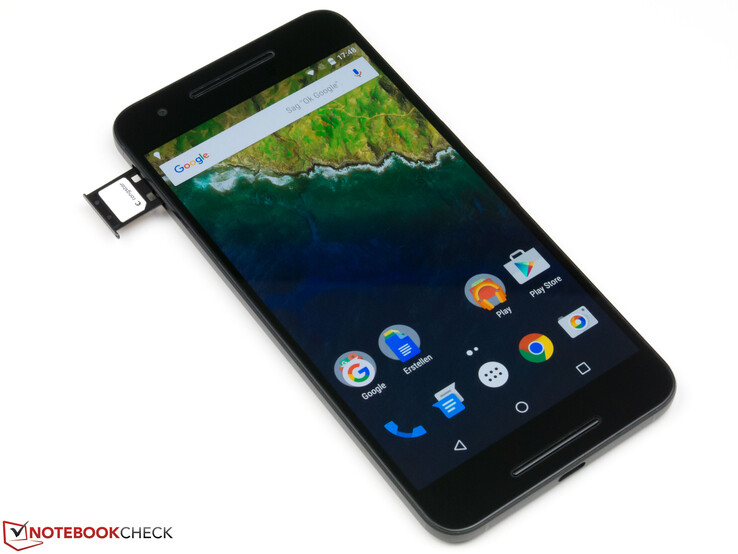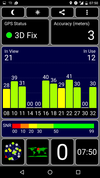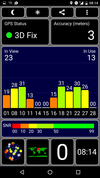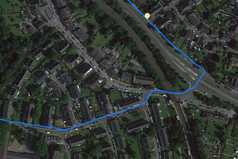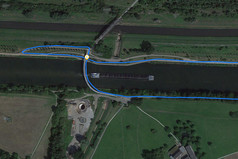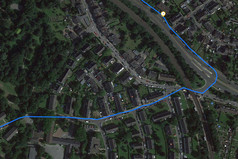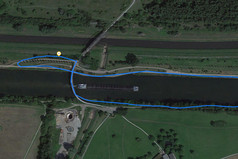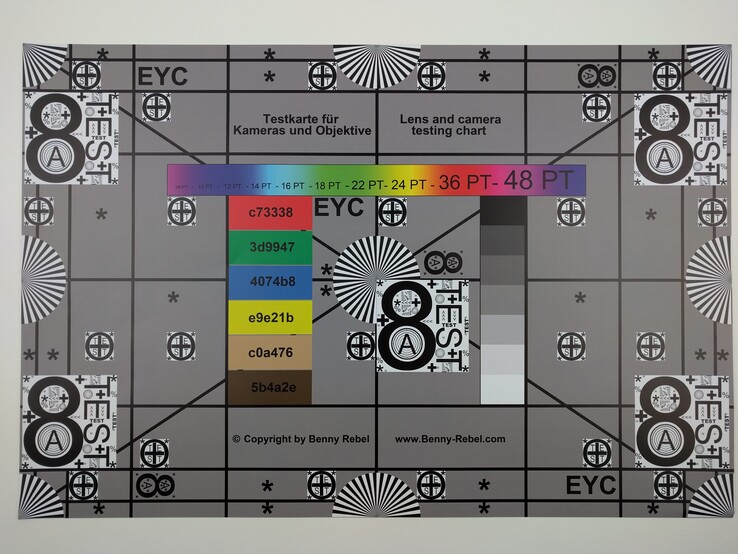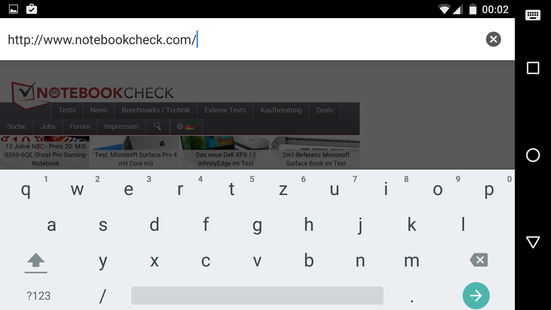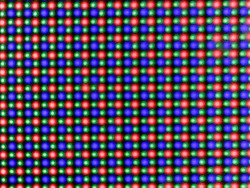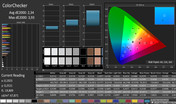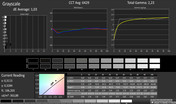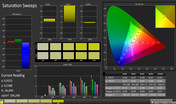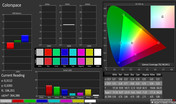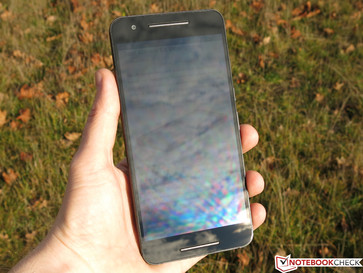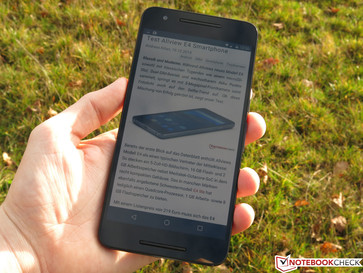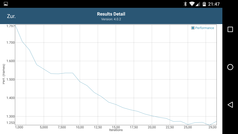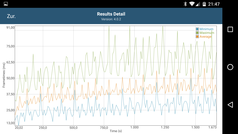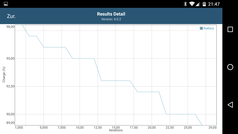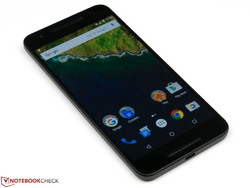Google Nexus 6P Smartphone Review

For the original German review, see here.
Google presented the usual new reference devices for the launch of Android 6.0 aka Marshmallow. Those devices are already shipped with the updated operating system. However, Google did not announce only one new smartphone, but two: While the Nexus 5X with its compact dimensions, which is manufactured by LG, is designed to attract customers of the Nexus 5 from 2013 in particular, the much larger Nexus 6P (produced by Huawei) is the successor of the Nexus 6 from last year. You can get it in three colors with 32, 64 or 128 GB for prices ranging between 649 and 799 Euros (~$709 to ~$873) from Google's online shop. The pricing is therefore identical to the previous models and is definitely targeting the high-end segment. Our review unit is the "Black Graphite" version with 32 GB internal storage.
Rivals for the Nexus 6P are mainly the flagship models from the competition. This list includes the 5.7-inch Android devices Samsung Galaxy S6 Edge+ as well as Motorola Moto X Style. Other alternatives are the slightly smaller 5.5-inch devices LG G4, Huawei Mate S as well as the OnePlus 2. The new Android device also competes against Apple's iPhone 6S Plus as well as Microsoft's new Lumia 950 XL.
Case
Thanks to the slightly smaller 5.7-inch instead of 6-inch display, the new Nexus 6P is mainly narrower than the previous Nexus 6: It is now around half a centimeter (~0.2 in) smaller. The thickness has also reduced from 10 to 7.5 millimeters (~0.4 to ~0.3 in). However, we were able to measure values of up to 8.5 millimeters (~0.33 in) in the area of the black glass at the back, where the main camera is located. It is nice that the elevated area extends over the whole width of the smartphone, so it is easy to use it when it is lying on the table and there are no noticeable tilting movements. On the other hand, the length has not really changed, which is rather unfortunate when you consider the smaller space requirements of the 5.7-inch panel. At 178 grams (~6.3 oz), the Nexus 6P is also slightly lighter than the predecessor (184 grams/~6.5 oz), but still quite heavy compared to the Nexus 5X at 136 grams (~4.8 oz). However, the high weight does create a certain sense of sophistication.
Huawei does not make any compromises in terms of materials for the Nexus 6P: Similar to the Mate S, the manufacturer uses an aluminum chassis, which does not only feel good in the hands, but also ensures a high stability. There are currently some videos on the Internet that are supposed to show that you can easily bend or even break the smartphone, but we cannot confirm this: Normal amounts of pressure are absolutely no problem and twisting attempts only resulted in a slightly visible bend. There were no creaking sounds, either. Moderate pressure on the display, which is covered by Gorilla Glass 4, was also no problem. However, we cannot rule out that the smartphone can be damaged if really hard force is inflicted.
There is no criticism for the build quality: The gaps are even and all edges are well rounded off.
Connectivity
While the less expensive Nexus 5X is only available with 16 or 32 GB internal storage, you can also get the Nexus 6P with 64 and 128 GB storage. This means that there is sufficient space for large media libraries despite the missing support for memory cards. We could use around 24.8 GB from our 32 GB review unit for our own files. The Nexus 6P has 3 GB of RAM and therefore 1 GB more than the smaller sibling.
Google has equipped the current Nexus models with the new USB Type-C port. It accepts the cable in both orientations, which is more comfortable in practice. The power adapter uses the same connector, which is why the Nexus 6P is also shipped with a short additional cable to connect the smartphone with common USB Type-A ports, so you can transfer files from a computer, for example. This is a small advantage over the Nexus 5X, which is shipped without such an accessory. It is rather unfortunate that neither USB 3.1 nor 3.0 are supported, so the maximum transfer rates are limited by the USB 2.0 standard. USB-OTG is also supported with a corresponding adapter cable.
The video output is not possible via MHL or Slimport, instead you can stream via Chromecast and DLNA in local networks. Bluetooth is available in the current version 4.2 and you also get NFC. Another handy feature is the reliable fingerprint scanner at the back of the smartphone as well as the multi-colored notification LED next to the front camera.
Software
As it is usual for the Nexus devices, users will get updates for the operating system directly from Google, which ensures a quick supply with security patches and new versions. The Nexus 6P, which was released recently, has already got an update from Android 6.0 to Android 6.0.1.
Android Marshmallow has introduced small visual changes compared to its predecessor Android Lollipop. The most noticeable difference is that you can now scroll vertically instead of horizontally through the app drawer. You also get the Ambient Display feature, which is already familiar from the Nexus 6. It can show the current time as well as notifications on the screen via movement sensor, when you lift the smartphone, for example.
Many users will also like that Android now offers a rights management for apps. Users therefore have the chance to deny individual rights for apps - like the location or access to the camera.
Communication & GPS
Similar to the Nexus 5X, the new Nexus 6P is also very well-equipped in terms of wireless communication: The dual-band AC Wi-Fi module managed gross transfer rates of up to 866 Mbps (2x2 MIMO) in a 5 GHz network with the Asus RT AC56U router. The signal quality was flawless and the range was above-average. The smartphone also goes all out when it comes to the supported frequencies, because you should be able to get a connection pretty much anywhere in the world. The smartphone also supports the fast LTE Cat. 6 standard (300 Mbps downstream, 50 Mbps upstream). Wireless data transfers with other devices are possible via the modern Bluetooth standard 4.2 as well as NFC.
The GPS module of the Nexus 6P also leaves a good impression: It will quickly find the location outdoors, and the location was also accurate in a one-story building with a flat roof. We checked the accuracy of the module on a bicycle ride and compared the results with the navigation device Garmin Edge 500. We can see that the smartphone is not quite as accurate as the professional device in the difficult sections like the bridge crossing, for example, but the difference of the overall track length is smaller than one percent. This is an excellent result, so the Nexus 6P should have no problems when you use it for navigation purposes.
Telephone & Voice Quality
Google has not really changed the Phone app in the new version of the operating system: You still get the familiar functions like favorites, history, integrated phonebook as well as a search. You can also fade in a number pad for the manual input of numbers. The design is quite simple, which makes it easy to use.
The call quality was flawless during test calls in the 3G network of T-Mobile: The understandability was great and there was no annoying static. The smartphone user also benefits from the great sound quality of the stereo speakers. We were understood easily, even though the Nexus user sounded rather dull. The only curious thing was the switch from the hands-free function back to the normal call: The microphone sensitivity of the review unit was reduced for a few seconds, so our voice was too quiet during that period. The Nexus 6P is shipped without a headset, despite the pretty high price.
Cameras & Multimedia
Both the Nexus 6P and the Nexus 5X are equipped with a 12.3 MP camera (4032x3024 pixels) with a pretty wide aperture of f/2.0. The modules are supposed to be identical, so it is not surprising that the pictures of the larger smartphone are also impressive. The quality is particularly good under daylight conditions, where thanks to the enormous sharpness and amount of details, the camera can beat the comparison devices. There is naturally more noise in darker environments, so you can see some grain. It is also slightly more pronounced compared to the iPhone 6S Plus, for example, but the Nexus 6P is still impressive with comparatively sharp and detailed results - so we are moaning on a high level. The dual-LED flash of the Nexus 6P emits a slightly cooler and darker light than the Nexus 5X. However, this is not visible on the pictures - quite the contrary: The pictures that were taken with the flash often have slightly warmer colors thanks to the matching white balance.
Two handy features are the quick autofocus as well as the quick access to the camera with a double tap on the power button, which also works directly from standby. However, the latter can also happen accidentally pretty quickly - when you put the phone in your pocket, for instance. Subjectively, the focusing of close ups in difficult lighting conditions was slightly faster compared to the Nexus 5X.
The current reference models from Google differ in terms of the front camera: While the Nexus 5X is equipped with a 5 MP webcam and an aperture of f/2.0, the Nexus 6P has an 8 MP sensor, but the sensor does capture less light due to the aperture of f/2.4. Close-range pictures under good lighting conditions are actually pretty good, although the quality will quickly decrease at longer distances and when it gets darker. Still, the sensor is more than sufficient for selfies.
Besides the normal picture mode, you can choose between "Photo Sphere", "Panorama" and "Focus Effect". Live filters or manual adjustments of ISO values, exposure, etc. are not available in the standard app.
The Nexus 6P can record UHD videos (3840x2160 pixels) at up to 30 fps. Similar to the Nexus 5X, the bit rate is quite high at around 41 Mbps, so the picture is hardly affected by compression artifacts. Therefore, still images look very good and show many details (see example screenshot). We had some software issue during the playback of UHD videos on the Nexus 5X but fortunately, there were no issues with the Nexus 6P. The webcam on the front can record in Full HD and the quality is usable, but there is a clear difference to the rear sensor due to the visibly lower resolution as well as the worse picture stabilizer.
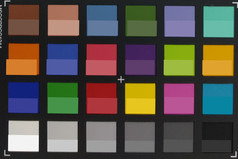
Color Accuracy & Sharpness
We use a picture of the X-Rite ColorChecker Passport under controlled lighting conditions to check the color accuracy of the Nexus 6P main camera. We did not edit the picture afterwards and there was no manual white balance.
Similar to the Nexus 5X, the blue and orange colors on the right side are particularly good. Most colors are slightly darker compared to the smaller sibling. The color temperature also appears to be a bit cooler in the grayscale presentation.
We take a picture of our test chart under controlled artificial light to evaluate the sharpness of the results. Once again, we can see the similarities to the Nexus 5X: The sharpness is excellent and there is hardly any decrease towards the peripheral areas.
Accessories
In addition to the powerful PSU with a USB Type-C connector (15 watts, 5V, 3 A), the box includes a 1.2 m (~4 ft) long cable with two USB Type-C connectors as well as a much shorter cable (30 cm/~12 in) to connect the smartphone with the common USB Type-A jack. You also find a small tool to open the SIM slot as well as several brochures (quick-start guide, warranty information, Google Play Music 30-day trial) in the box. Google offers several optional accessories like cases in its online-store.
Warranty
According to the brochures, the Nexus 6P has a warranty period of two years from Huawei, but the battery and the power adapter are covered for only six months.
Input Devices & Handling
Unlike the Nexus 5X, where the display is protected by Gorilla Glass 3, the Nexus 6P is equipped with Gorilla Glass 4. However, this does not make a big difference for the user, because both screens provide good gliding capabilities for the fingers. We cannot criticize the precision either, inputs are executed accurately and without delays.
Nexus smartphones usually use the standard Android keyboard, and there is hardly any criticism: All the important functions are available and easy to use. If you want to use special features, you can obviously download other keyboards from the Play Store.
All the hardware buttons of the Nexus 6P are on the right side of the chassis, similar to the Nexus 5X. They have a well-defined pressure point and do not clatter. The power button also has a perceptible surface structure, so it is easy to distinguish from the volume rocker.
The fingerprint scanner at the back is fast and reliable – failed first attempts were rare. The unlocking of the device is very comfortable with this method.
The operating system was always smooth, there were no stutters even when we closed complex apps. Thanks to the integrated position sensors, the quick display orientation is no problem for the smartphone.
Display
The Nexus 6P is equipped with a 5.7-inch AMOLED screen with the QHD resolution, which results in a very high pixel density of 515 PPI. This is not the best result within the comparison – see LG G4 @534 PPI – but you will not be able to see a difference. Subjectively, all the contents are very sharp, and we cannot see individual pixels from a normal viewing distance.
The luminance in the center is 363 cd/m² on a completely white picture, which surpasses the results of other AMOLED based rivals. The predecessor Nexus 6 is clearly beaten as well. However, the results of an even distribution of bright and dark display contents (Average Picture Level/APL 50) are more significant. The Nexus 6P manages an even higher result of 411 cd/m² in this case, and the results did not change when we activated the automatic brightness control. All the IPS-based rivals are even brighter, but cannot benefit from the extremely high contrast ratios that AMOLED screens manage thanks to the absolute black value.
| |||||||||||||||||||||||||
Brightness Distribution: 90 %
Center on Battery: 363 cd/m²
Contrast: ∞:1 (Black: 0 cd/m²)
ΔE ColorChecker Calman: 2.34 | ∀{0.5-29.43 Ø4.79}
ΔE Greyscale Calman: 1.03 | ∀{0.09-98 Ø5}
Gamma: 2.23
CCT: 6429 K
| Google Nexus 6P 2560x1440 px 5.7'' (AMOLED) | Google Nexus 5X 1920x1080 px 5.2'' (IPS) | Google Nexus 6 2560x1440 px 6.0'' (AMOLED) | LG G4 2560x1440 px 5.5'' (IPS) | OnePlus 2 1920x1080 px 5.5'' (IPS) | Huawei Mate S 1920x1080 px 5.5'' (AMOLED) | Samsung Galaxy S6 Edge+ 2560x1440 px 5.7'' (AMOLED) | Apple iPhone 6S Plus 1920x1080 px 5.5'' (IPS) | |
|---|---|---|---|---|---|---|---|---|
| Screen | ||||||||
| Brightness middle (cd/m²) | 363 | 503 39% | 274 -25% | 566 56% | 451 24% | 352 -3% | 335.7 -8% | 583 61% |
| Brightness (cd/m²) | 365 | 498 36% | 264 -28% | 536 47% | 446 22% | 350 -4% | 332 -9% | 560 53% |
| Brightness Distribution (%) | 90 | 97 8% | 89 -1% | 90 0% | 90 0% | 87 -3% | 89 -1% | 91 1% |
| Black Level * (cd/m²) | 0.38 | 0.47 | 0.3 | 0.46 | ||||
| Colorchecker dE 2000 * | 2.34 | 2.09 11% | 6.99 -199% | 6.17 -164% | 3.84 -64% | 4.95 -112% | 2.33 -0% | 3.55 -52% |
| Greyscale dE 2000 * | 1.03 | 2.12 -106% | 4.01 -289% | 6.26 -508% | 3.97 -285% | 6.54 -535% | 2.15 -109% | 3.88 -277% |
| Gamma | 2.23 99% | 2.27 97% | 2.03 108% | 2.48 89% | 2.46 89% | 2.27 97% | 2.15 102% | 2.2 100% |
| CCT | 6429 101% | 6621 98% | 6329 103% | 8171 80% | 7283 89% | 6943 94% | 6184 105% | 7280 89% |
| Contrast (:1) | 1324 | 1204 | 1503 | 1267 | ||||
| Color Space (Percent of AdobeRGB 1998) (%) | 65.48 | 58.07 | 59.05 | |||||
| Color Space (Percent of sRGB) (%) | 98.63 | 90.14 | 92.8 |
* ... smaller is better
The precise color representations of the Nexus 5X have already been quite impressive, but the Nexus 6P is even better: The average DeltaE deviation for the grayscale is just 1.03, and the colors are more than acceptable at 2.23 (ideal value <3). The color temperature is almost perfect at 6429 K (ideal: 6500 K) and the gamma value does not fall behind at 2.23 (ideal: 2.2).
It is easy to use the Nexus 6P outdoors, as long as you avoid direct sunlight on the display, otherwise you will get annoying reflections and in some cases also colored interference patterns. The excellent contrast of the AMOLED screen as well as the comparatively high luminance for this the panel technology can otherwise ensure a comfortable visibility in bright environments.
The viewing angle stability of the AMOLED screen inside the Nexus 6P is almost perfect. There are no inversions due to the technology and the luminance decrease is very low when you look at the panel from the side. You can only see a colorful pattern from extreme angles, which should not be important in practice.
Performance
While the smaller Nexus 5X is equipped with Qualcomm's hexa-core SoC Snapdragon 808, the Nexus 6P gets the high-end octa-core SoC Snapdragon 810 in the revision 2.1. The latter is based on four frugal Cortex-A53 cores (up to 1.5 GHz) as well as four Cortex-A57 cores (up to 2.0 GHz). The graphics are handled by the Adreno 430 GPU.
The performance of the Nexus 6P is quite decent in many benchmarks, and usually surpasses the predecessor Nexus 6 as well as the devices with a Snapdragon 808 SoC. Only the Linpack benchmark shows a clear outlier, but we could already observe that in the review of the Nexus 5X. Similar to this review, we believe that only the slower Cortex-A53 cores of the SoC are used for this test. It is never fast enough for the top devices, because the OnePlus 2, the Apple iPhone 6S Plus and the Samsung Galaxy S6 Edge+ are usually slightly more powerful.
The Nexus 6P obviously falls behind the FHD rivals in GPU benchmarks that use the native display resolution. This can be seen in the T-REX HD Onscreen test of GFXBench, where the OnePlus 2 with the same SoC has an advantage of 42% – even the Nexus 5X with the slower Adreno 418 GPU manages higher frame rates in this test.
We have to mention that the results of the Nexus 6P can vary significantly depending on the load situation prior to the benchmark, because the SoC quickly loses part of its performance when it gets warm (see section Temperature).
| AnTuTu v5 - Total Score (sort by value) | |
| Google Nexus 6P | |
| Google Nexus 5X | |
| Google Nexus 6 | |
| LG G4 | |
| OnePlus 2 | |
| Huawei Mate S | |
| Samsung Galaxy S6 Edge+ | |
| Apple iPhone 6S Plus | |
| Geekbench 3 | |
| 64 Bit Multi-Core Score (sort by value) | |
| Google Nexus 6P | |
| Google Nexus 5X | |
| LG G4 | |
| OnePlus 2 | |
| Huawei Mate S | |
| Samsung Galaxy S6 Edge+ | |
| Apple iPhone 6S Plus | |
| 64 Bit Single-Core Score (sort by value) | |
| Google Nexus 6P | |
| Google Nexus 5X | |
| LG G4 | |
| OnePlus 2 | |
| Huawei Mate S | |
| Samsung Galaxy S6 Edge+ | |
| Apple iPhone 6S Plus | |
| Linpack Android / IOS | |
| Multi Thread (sort by value) | |
| Google Nexus 6P | |
| Google Nexus 5X | |
| LG G4 | |
| OnePlus 2 | |
| Huawei Mate S | |
| Apple iPhone 6S Plus | |
| Single Thread (sort by value) | |
| Google Nexus 6P | |
| Google Nexus 5X | |
| LG G4 | |
| OnePlus 2 | |
| Huawei Mate S | |
| Apple iPhone 6S Plus | |
| PCMark for Android - Work performance score (sort by value) | |
| Google Nexus 6P | |
| Google Nexus 5X | |
| LG G4 | |
| OnePlus 2 | |
| Huawei Mate S | |
| Samsung Galaxy S6 Edge+ | |
| GFXBench (DX / GLBenchmark) 2.7 | |
| T-Rex Onscreen (sort by value) | |
| Google Nexus 6P | |
| Google Nexus 5X | |
| Google Nexus 6 | |
| LG G4 | |
| OnePlus 2 | |
| Huawei Mate S | |
| Apple iPhone 6S Plus | |
| 1920x1080 T-Rex Offscreen (sort by value) | |
| Google Nexus 6P | |
| Google Nexus 5X | |
| Google Nexus 6 | |
| LG G4 | |
| OnePlus 2 | |
| Huawei Mate S | |
| Apple iPhone 6S Plus | |
| GFXBench 3.1 | |
| 1920x1080 Manhattan ES 3.1 Offscreen (sort by value) | |
| Google Nexus 6P | |
| LG G4 | |
| OnePlus 2 | |
| Huawei Mate S | |
| Apple iPhone 6S Plus | |
| on screen Manhattan ES 3.1 Onscreen (sort by value) | |
| Google Nexus 6P | |
| LG G4 | |
| OnePlus 2 | |
| Huawei Mate S | |
| Apple iPhone 6S Plus | |
The situation changes in the browser benchmarks, where the results of the Nexus 6P are much better. Except for the iPhone 6S Plus, our review unit can beat all the comparison devices while the Galaxy S6 Edge+ is the only Android device that can beat the Nexus 6P in Google's V8 test and the JetStream benchmark.
| Octane V2 - Total Score (sort by value) | |
| Google Nexus 6P | |
| Google Nexus 5X | |
| Google Nexus 6 | |
| LG G4 | |
| OnePlus 2 | |
| Huawei Mate S | |
| Samsung Galaxy S6 Edge+ | |
| Apple iPhone 6S Plus | |
| Sunspider - 1.0 Total Score (sort by value) | |
| Google Nexus 6P | |
| Google Nexus 5X | |
| Google Nexus 6 | |
| LG G4 | |
| OnePlus 2 | |
| Huawei Mate S | |
| Samsung Galaxy S6 Edge+ | |
| Apple iPhone 6S Plus | |
| Mozilla Kraken 1.1 - Total (sort by value) | |
| Google Nexus 6P | |
| Google Nexus 5X | |
| Google Nexus 6 | |
| LG G4 | |
| OnePlus 2 | |
| Huawei Mate S | |
| Samsung Galaxy S6 Edge+ | |
| Apple iPhone 6S Plus | |
| WebXPRT 2015 - Overall (sort by value) | |
| Google Nexus 6P | |
| Google Nexus 5X | |
| LG G4 | |
| OnePlus 2 | |
| Huawei Mate S | |
| Samsung Galaxy S6 Edge+ | |
| Apple iPhone 6S Plus | |
| Google V8 Ver. 7 - Google V8 Ver. 7 Score (sort by value) | |
| Google Nexus 6P | |
| Google Nexus 5X | |
| Google Nexus 6 | |
| LG G4 | |
| OnePlus 2 | |
| Samsung Galaxy S6 Edge+ | |
| Apple iPhone 6S Plus | |
| JetStream 1.1 - Total Score (sort by value) | |
| Google Nexus 6P | |
| Google Nexus 5X | |
| LG G4 | |
| OnePlus 2 | |
| Huawei Mate S | |
| Samsung Galaxy S6 Edge+ | |
| Apple iPhone 6S Plus | |
* ... smaller is better
Huawei uses a similarly fast storage for the Nexus 6P as LG does in the Nexus 5X. The sequential transfer rates are average within the comparison, but we can see a small weakness in terms of the read and write transfer rates of small data blocks. Nevertheless, the storage performance is significantly better compared to the predecessor Nexus 6.
| BaseMark OS II - Memory (sort by value) | |
| Google Nexus 6P | |
| Google Nexus 5X | |
| Google Nexus 6 | |
| LG G4 | |
| OnePlus 2 | |
| Huawei Mate S | |
| Samsung Galaxy S6 Edge+ | |
| Apple iPhone 6S Plus | |
Games
The Adreno 430 GPU inside the Nexus 6P is one of the most powerful smartphone GPUs you can currently get, but it also has to drive a high-resolution QHD panel. Complex games like "Asphalt 8" can be played well with the highest graphics settings, but we sometimes had the impression that very busy scenes in some levels were even smoother on medium settings. This is obviously criticism on a very high level of a very solid performance. Less demanding games like "Angry Birds 2", for example, are no problem at all for the powerful hardware.
Both the integrated sensors as well as the sensitive touchscreen work very well when you play games and the stereo speakers at the front are not covered by the hands when you hold the smartphone in landscape mode.
Emissions
Temperature
The Nexus 6P is a very cool smartphone with idle temperatures of around 27 °C (~81 °F) - the large metal surface that can dissipate the heat more effectively is certainly an advantage over devices with plastic cases. The maximum temperatures of up to 38 °C (~100 °F) under maximum load are not too high, either. The device gets warm in the hands pretty quickly, but it is never inconveniently hot. It seems that Huawei has done a nice job when you consider the earlier heat issues of the Snapdragon 810 as well as the much warmer rivals (OnePlus 2: up to 45.8 °C/~114 °F; LG G4: up to 44.3 °C/~112 °F).
We use the GFXBench Battery Test to check if these moderate temperatures are a result of excessive throttling. The test repeats the T-Rex test thirty times and logs the performance, the temperature increase and the battery capacity. The results show that the processor can only utilize its full performance in the first run, the second pass is 5% slower and it will continue to drop. The graph reaches the bottom after 25 passes, where the Snapdragon 810 loses around 25% of its original performance. There are similarities to the same SoC inside the OnePlus 2: The latter can maintain a steady performance for around three passes, but it will drop faster to the final value that is around 30% lower than the original result. The problem is that the chip has less performance reserves because of the QHD resolution compared to the FHD panel of the OnePlus 2. The throttling could therefore also be an issue after a while when you play very demanding games.
(+) The maximum temperature on the upper side is 38.8 °C / 102 F, compared to the average of 35.2 °C / 95 F, ranging from 21.9 to 247 °C for the class Smartphone.
(+) The bottom heats up to a maximum of 36.7 °C / 98 F, compared to the average of 34 °C / 93 F
(+) In idle usage, the average temperature for the upper side is 27.3 °C / 81 F, compared to the device average of 32.9 °C / 91 F.
Speakers
While the Nexus 5X has only an average speaker on the front, the Nexus 6P is pretty impressive with its stereo system: Music sounds quite natural and much richer compared to many other smartphones. There are also hardly any distortions at the maximum volume. This is obviously an advantage for the hands-free operation, which is no problem. Thanks to the clever position of the speakers on the front, the sound is not affected when the device is lying on a table or in our hands.
There is no headset in the box of the smartphone, but you can still use normal headphones via the 3.5 mm stereo jack. The sound was excellent without any static.
Energy Management
Power Consumption
The Nexus 6P leaves a rather mixed impression in the consumption measurements: While the review unit beats many other high-end modules in the idle tests thanks to the comparatively low values, it needs much more power than all the other models under medium load.
The included power adapter has a nominal output of 15 watts (5 V, 3 A) and can fully charge the 3450 mAh battery within 100 minutes. Wireless charging is not supported.
| Off / Standby | |
| Idle | |
| Load |
|
Key:
min: | |
| Google Nexus 6P Adreno 430, 810 MSM8994, 32 GB eMMC Flash | Google Nexus 5X Adreno 418, 808 MSM8992, 32 GB eMMC Flash | Google Nexus 6 Adreno 420, 805 APQ8084, 32 GB eMMC Flash | LG G4 Adreno 418, 808 MSM8992, 32 GB eMMC Flash | OnePlus 2 Adreno 430, 810 MSM8994, 64 GB eMMC Flash | Huawei Mate S Mali-T628 MP4, Kirin 935, 32 GB eMMC Flash | Samsung Galaxy S6 Edge+ Mali-T760 MP8, Exynos 7420, 32 GB UFS 2.0 Flash | Apple iPhone 6S Plus A9 / PowerVR GT7600, A9, Apple AP0064K (iPhone NVMe) | |
|---|---|---|---|---|---|---|---|---|
| Power Consumption | -2% | -21% | -23% | -4% | 10% | -6% | ||
| Idle Minimum * (Watt) | 0.83 | 0.55 34% | 1.2 -45% | 1.1 -33% | 0.6 28% | 0.6 28% | 0.5 40% | |
| Idle Average * (Watt) | 1.09 | 1.44 -32% | 1.5 -38% | 1.5 -38% | 1.7 -56% | 1.2 -10% | 1.9 -74% | |
| Idle Maximum * (Watt) | 1.17 | 1.9 -62% | 1.7 -45% | 1.9 -62% | 1.8 -54% | 1.6 -37% | 2.2 -88% | |
| Load Average * (Watt) | 7.49 | 3.36 55% | 4.8 36% | 6.6 12% | 5.7 24% | 4.1 45% | 3.2 57% | |
| Load Maximum * (Watt) | 9.51 | 9.76 -3% | 10.9 -15% | 8.8 7% | 6 37% | 7.4 22% | 6.4 33% |
* ... smaller is better
Battery Runtime
Despite the many new energy-saving mechanism like "Doze" and "App-Standby", which were introduced with Android 6.0, the Nexus 6P only manages average results in terms of the maximum battery runtime. It can beat the LG G4 as well as the OnePlus 2 in the more realistic Wi-Fi test, but the Huawei Mate S, the Samsung Galaxy S6 Edge+ and the Apple iPhone 6S Plus last even longer. The situation is similar in the video test, where the review unit is once again beaten by many rivals. The result under load on the other hand is good: The Nexus 6P is at the top of the ranking with the Huawei Mate S. The runtimes are therefore pretty average within our comparison group.
The integrated energy-saving mode of Android 6.0 can either automatically be activated at a certain remaining battery capacity or manually. It will reduce the performance of the smartphone and reduce background activities. The user also has to do without the vibrate function.
| Google Nexus 6P Adreno 430, 810 MSM8994, 32 GB eMMC Flash | Google Nexus 5X Adreno 418, 808 MSM8992, 32 GB eMMC Flash | Google Nexus 6 Adreno 420, 805 APQ8084, 32 GB eMMC Flash | LG G4 Adreno 418, 808 MSM8992, 32 GB eMMC Flash | OnePlus 2 Adreno 430, 810 MSM8994, 64 GB eMMC Flash | Huawei Mate S Mali-T628 MP4, Kirin 935, 32 GB eMMC Flash | Samsung Galaxy S6 Edge+ Mali-T760 MP8, Exynos 7420, 32 GB UFS 2.0 Flash | Apple iPhone 6S Plus A9 / PowerVR GT7600, A9, Apple AP0064K (iPhone NVMe) | |
|---|---|---|---|---|---|---|---|---|
| Battery runtime | 6% | -16% | -16% | -5% | 9% | 4% | 14% | |
| Reader / Idle (h) | 24.1 | 29.6 23% | 19.2 -20% | 27.6 15% | 23.2 -4% | 18.7 -22% | 24.3 1% | 27.6 15% |
| H.264 (h) | 8.9 | 9.3 4% | 10.9 22% | 8.4 -6% | 9.7 9% | 9.5 7% | 11.9 34% | |
| WiFi v1.3 (h) | 6.3 | 6.9 10% | 5.4 -14% | 5.9 -6% | 9.6 52% | 8.4 33% | 8.6 37% | |
| Load (h) | 4.7 | 4.1 -13% | 2.3 -51% | 1.9 -60% | 3.8 -19% | 4.7 0% | 3.7 -21% | 3.3 -30% |
| WiFi (h) | 10 |
Pros
Cons
Verdict
Google's flagship Nexus 6P can impress in many respects. In addition to a powerful SoC, you get 3 GB of RAM as well as numerous current standards for wireless communication. Besides AC Wi-Fi with up to 866 Mbps, the smartphone also supports Bluetooth 4.2 as well as NFC and many mobile frequencies. In practice, it can convince with good phone features, a fast operating system, a great camera and a reliable fingerprint scanner. It is also nice that you get a very accurate GPS module. The high-contrast 5.7-inch AMOLED display, which impressed with excellent colors, is another highlight of the smartphone.
While the smaller sibling Nexus 5X is only available with up to 32 GB storage, you can also get the Nexus 6P with up to 128 GB, so there is enough space for large media libraries. As it is usual for Google devices, you cannot expand the storage capacity via microSD-card.
Despite the 3450 mAh battery and the clearly measurable throttling under load the average runtimes are rather disappointing. On the other hand, the device does not get too warm.
The Nexus 5X had already got a very good rating, and this is even more so for the larger Nexus 6P, because it offers all the virtues of the smaller model as well as better speakers, a larger panel and more storage capacity if necessary. Many users will also like the high-quality aluminum chassis.
You will have to decide for yourself if the advantages are worth the hefty additional charge of 120 Euros (~$131) over the new Nexus 5X. If you are willing to do without the direct Android updates by Google, it is also worth looking at the competition: The LG G4, for example, is already available for around 450 Euros (~$491) and even supports expandable storage as well as an easily accessible battery.
Google Nexus 6P
- 04/13/2016 v5 (old)
Andreas Kilian




